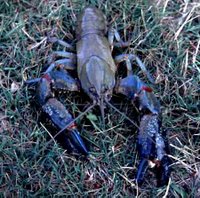Dear Blue Lobster:
Is molting-time the only time hermit crabs burrow down into the substrate? My small hermie has completely buried herself down under the moss that is in one corner of her habitat. The habitat is a 20-gallon aquarium with about 3 inches of sand over 80% of it. For variety, I put a gravel area in one corner and a moss area in another. Maybe she just likes the moss, but I am concerned that she might be starting to molt. There are 3 other crabs in the tank, one a little bit larger than her, and 2 that are quite a bit larger.
... I know you aren't supposed to move a molting crab, but considering that she's buried herself in moss rather than sand (and the moss isn't even very moist), and she is not isolated from these larger hermies.... Should I just leave her be??
Dear Gentle Sir:
It sounds to me like your hermit crab is depressed. Like people, hermit crabs often seek dark places when experiencing emotional lows. Since your crab is not fully-grown, this could be a case of adolescent depression as your hermit tries to find its place in the world and establish a unique personal identity for itself; however, it's also possible that this is a chronic hormonal imbalance that will require medication and therapy. Hurry your hermit crab to the vet to get a full diagnosis.
In the meantime, you can try to brighten your hermit crab's life up a little with some music. As your hermit crab lives in the sand, under bright lights, something upbeat like the Beach Boys or Jan and Dean are good choices. Place a little speaker next to or inside of the tank and play at a moderate volume. Your hermit and his tank mates can have little beach parties which will also induce exercise and a friendly environment, two things great for beating depression. Avoid music like Depeche Mode or Nine Inch Nails which will only serve to further sink your crab into melancholy.
Another idea to bring joy into your hermit crab's life is to introduce decorations to the tank. You can find a variety of miniature castles at your local pet supply store, as well as fake divers, treasure chests, and palm trees. Action figures could add a new dimension of life to the tank too. Fellow crustaceans will make your hermit crab feel more at ease with his new plastic neighbors and engender a sense of crustacean fraternization that will boost his confidence, making him feel part of the in crowd.

